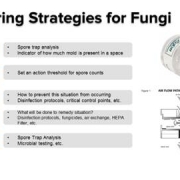The Toxic Effects of Fungal Exposure
Once one is tested and diagnosed with mycotoxicosis, one should begin to try to assess the extent of the fungal infection and how impaired, if any, one may be. This is exceptionally important as most physicians are inexperienced in dealing with this illness, and finding out as much as one can would possibly most helpful in describing symptoms and effective treatments.
Fungi have long been known to affect human well being in various ways, including disease of essential crop plants, decay of stored foods with possible concomitant production of mycotoxins, superficial and systemic infection of human tissues, and disease associated with immune stimulation such as hypersensitivity pneumonitis and toxic pneumonitis. The spores of a large number of important fungi are less than 5mm aerodynamic diameter, and therefore are able to enter the lungs. They also may contain significant amounts of mycotoxins. Diseases associated with inhalation of fungal spores can toxic pneumonitis, hypersensitivity pneumonitis, tremors, chronic fatigue syndrome, kidney failure, and cancer.
Exposure to molds has become a significant health risk to an increasing number of workers in various occupations throughout the nations. Fungal antigens are able to cause occupational asthma, rhinoconjunctivitis, hypersensitivity pneumonitis, and organic dust toxic syndrome(ODTS). In recent years, an increasing incidence of mold-induced diseases has been encountered in moldy contaminated water-damaged buildings. This has occurred both in homes and workplaces. Symptomatic persons occupying moisture problem buildings may develop asthma, rhinitis, ODTS and HP.
There is more information in these references, which fully illustrate the impact when the inhalation of these mycotoxins can have on the body, including the mucous membranes; often mistaken for an “allergic” reaction. Many allergists are often obsolete on today’s changing medicine and the new tests that are available to determine pathogenic mold and often mistake it for allergies since they are easily disguised to the unskilled eye. There are, however, distinct initial differences due to inhalation of these mycotoxins can have such a profound shock on the body, and mounting evidence to back up the fact that there is a direct correlation to other serious illnesses. The difference between a good physician and an inept one is one who will listen intently to what you are saying and ask questions, rather than write prescriptions for symptoms and not hear what you fully have say as far as what the underlying cause may be.
When the World Health Organization convened in 2002, Dr. A.V. Costantini, head of the organization; an internist who claims to be a simple country doctor, listed fourteen diseases wherein fungal (mold and Candida Albicans forms) microorganisms have been found include the following: atherosclerosis, cancer, AIDS, diabetes mellitus, rheumatoid arthritis, Sjogren’s syndrome, systemic lupus erythematosus, gout, Crohn’s disease, Multiple sclerosis, hyperactivity syndrome, infertility, psoriasis, cirrhosis of the liver, Alzheimer’s disease, Scleroderma, Raynaud’s Disease, Sarcoidosis, kidney stones, Amyloidosis, Vasculitis and Cushing’s Disease.
Dr. Costantini believes that the concept of “auto-immune” diseases contains a fatal flaw, because no successful species can develop a system of defense which attacks itself. Antibodies that are measured in the blood stream and which imply an autoimmune condition are actually antibodies against ubiquitin, a substance that is present in many species including that of fungi.
Antifungal, anti-mycoplasmic treatments according to Dr. Costantini, by treating various so-called autoimmune diseases with antifungals, including Systemic lupus erythematosus and lichen sclerosis, the disease can possibly be halted. However, many species have become so virulent that treatment may often have to be combined with diet, vitamin/enzymes, and other non-traditional treatments. There has also been question lately if nano bacteria has been playing into the part of the part of patients who have been having relapses as there has always been a balance of fungi and bacteria in the body before infection occurred.
Among the traditional drugs are found Lovastatin, Griseofulvin, Ketaconazole, Neomycin, Fibrates,Tetracycline and others, some of which may also be effective against Lupus. However, these should all be administered by a health professional, with due consideration for their adverse effects, including that of killing off beneficial microbes, lactobacillus acidophilus, in the intestinal tract.
Growth of commonly occurring filamentous fungi in foods may result in production of toxins known as mycotoxins, which can cause a variety of ill effects in humans, from allergic responses to immunosuppression and cancer. The most dangerous mycotoxins are aflatoxins, ochratoxin A, fumonisins, trichothecenes and zearalenone. Aflatoxins are potent carcinogens and, in association with hepatitis B virus, are responsible for many thousands of human deaths per annum, mostly in non-industrialized tropical countries. Ochratoxin A is a carcinogen, and has caused urinary tract cancer and kidney damage in people from northern and eastern Europe. Fumonisins appear to be the cause of oesophageal cancer in southern Africa, parts of China and elsewhere. Trichothecenes are highly immunosuppressive and zearalenone causes estrogenic effects in animals and man.
Read the original article at www.mold-survivor.com
By Susan Lillard-Roberts
This site is not intended to give medical advice. Seek the advice of a professional for diagnosis, medication, treatment options, and complete knowledge of any illness. The opinions expressed here are exclusively my personal opinions do not necessarily reflect my peers or professional affiliates. The information here does not reflect professional advice and is not intended to supersede the professional advice of others.

 Cannabisindustryjournal.com
Cannabisindustryjournal.com 




